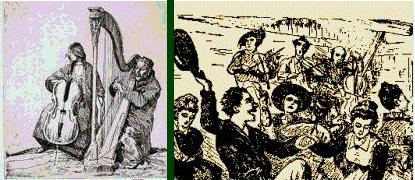Also copied from parts of a Cello Chat post:
So, if we have so many disadvantages, then why bother?
Well, of course, there’s The Tone. Ain’t nothin’ like it; it adds class to a flock of tinkly dulcimers, strummin’ git-tars, twangy bangos (spelling intentional), and squeaky fiddles.
It turns out it’s actually a good thing that cello’s not just an octave violin. How wise were those early designers! Because of its octave-plus-a-fifth lower tuning, it can perform in one or more of several roles ---
Played by a beginner: (1) it can take the role of string bass (plucked or bowed), (2) it is well-suited for song-speed melodies in typical vocal keys, and (3) it can play back-beats, “potatoes”, and simple groove rhythms in pitches well removed from the melody.
For the intermediate: (4) harp-like strummed/plucked accompaniments, (5) rich harmonizations in that beefy, baritone, octave-plus-a-third to an octave-plus-a-sixth or so, range below fiddle-keyed melodies, (6) beautifully airs in that tenor range one octave lower than fiddle pitch, and (7) some fast tunes in fiddle keys --- either one, two, or often, a combination of both one and two octaves below fiddle pitch
And for the advanced (to which I aspire): ( 8 ) exciting and driven groove patterns, and (9) tunes and harmonizations all over the fingerboard, from deep in the low grumblies to the upper areas of the treble clef staff. Will I get there? Who cares! The joy is in the journey.
For (1), you’ll want to learn to identify chord changes, at least in the root notes. I’m not great at it, but I know if I listen and experiment with it quietly, I’ll eventually get it. After a while you get to recognize certain patterns right off the bat, like I-IV-I-V I-IV-V-I, or VI7-II7-V7-I, or i-VII-i-VII(or v)-i.
Regarding (2), ever notice that songs for general singing, like in a hymnal or Christmas book, typically extend up only to D or E? This works out very nicely for cello learners still limited to 1st and 2nd position. There’s no shortage of written tunes in that range. Try playing/recording well-known Christmas Carols and your intonation limitations will become all too obvious.
For (3), some books address this, but so does watching others and using your imagination: doo-wada-doo-wada-doo-wada... or boom, ka-chk, boom, ka-chk-a-chk, boom, ka-chk… or whatever. Copy and experiment.
But for these you need to know some basic theory. Be able to spell any chord. Read or figure out tunes by ear. Understand how chords migrate to-from the tonic. Select the right note for the situation.
Time spent with a teacher following any of the commonly available methods, like Suzuki, All For Strings, Essential Elements, Feuilliard, or whatever, provides a physical foundation and you gotta have that foundation. Remember, if you can’t yet play Vivaldi, you can’t yet play typical fiddle tunes, anyway. It can come, but it’s gonna take time on the instrument with formal lessons and playing formal stuff.
Ok, now I’ve got my pontificating urge out of me. I hope to soon answer the question and comment on some of the books with which I'm familiar on the good lists Jim and Marilyn have provided.

Old World or New, Sacred or Profane
Subscribe to:
Post Comments (Atom)
1 comment:
Tag, you're it!!
Post 7 things about youself!
-Mike
Post a Comment